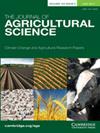A Multi-sensor Analysis of Selected Reflectance-Based Crop Coefficient Models for Daily Maize Evapotranspiration Estimation
IF 1.7
4区 农林科学
Q2 AGRICULTURE, MULTIDISCIPLINARY
引用次数: 0
Abstract
This study evaluated three reflectance-based crop coefficient models (RBCC) for daily maize actual evapotranspiration (ETa) estimates, using multispectral data from spaceborne, airborne, and proximal platforms. The goal was to identify the optimal multispectral sensor that gives more accurate daily ETa estimates. The remote sensing (RS) multispectral platforms included Landsat-8, Sentinel-2, Planet CubeSat, handheld multispectral radiometer (MSR), and unmanned aerial system or UAS, spatial resolution from 30 m to 0.03 m. Three RBCC models that use different vegetation indices as input variables were evaluated in the study. One RBCC uses the normalized difference vegetation index (NDVI). The second model uses the soil-adjusted vegetation index (SAVI), and the third model uses canopy cover (fc). The data for this study were from two maize research sites in Greeley and Fort Collins, Colorado, USA, collected in 2020 and 2021. The Greeley site had a subsurface drip system, while the Fort Collins site had surface irrigation (furrow). Daily maize ETa predictions were compared with observed daily maize ETa data from an Eddy Covariance system installed at each research site. Results indicated that, depending on the RS of ETa algorithm and platform, the optimal input RS data was different. The MSR sensor (1 m) provided the best remote sensing data (input) for the SAVI-based RBCC ETa model, with a maize ETa error (MBE±RMSE) of -0.13 (-3%)±0.67 (16%) mm/d. Sentinel-2 was the best sensor for the remaining two RBCC daily maize ETa algorithms, since the errors for the NDVI-based and fc-based RBCC models for maize ETa were 0.21 (5%)±0.78 (18%) mm/d and 0.59 (14%)±1.07 (25%) mm/d, respectively. These results indicate the need for methods to improve the spectral quality of the remote sensing data to improve spatial ETa estimates and advance sustainable irrigation water management.基于反射率作物系数模型的玉米日蒸散估算多传感器分析
本研究利用来自星载、航空和近地平台的多光谱数据,评估了三种基于反射率的作物系数模型(RBCC)对玉米日实际蒸散量(ETa)的估计。目标是确定最佳的多光谱传感器,以提供更准确的每日ETa估计。遥感(RS)多光谱平台包括Landsat-8、Sentinel-2、Planet CubeSat、手持式多光谱辐射计(MSR)和无人机系统(UAS),空间分辨率从30 m到0.03 m。采用不同的植被指数作为输入变量,对3种RBCC模型进行了评价。一种RBCC使用归一化植被指数(NDVI)。第二个模型使用土壤调整植被指数(SAVI),第三个模型使用冠层覆盖度(fc)。本研究的数据来自美国科罗拉多州格里利和柯林斯堡的两个玉米研究点,收集于2020年和2021年。格里利遗址有地下滴灌系统,而柯林斯堡遗址有地表灌溉(沟)。将每日玉米ETa预测数据与安装在每个研究站点的涡流相关方差系统的每日玉米ETa观测数据进行比较。结果表明,根据ETa算法的RS和平台的不同,最优输入RS数据是不同的。MSR传感器(1 m)为基于save的RBCC ETa模型提供了最佳的遥感数据(输入),其玉米ETa误差(MBE±RMSE)为-0.13 (-3%)±0.67 (16%) mm/d。Sentinel-2是其余两种RBCC每日玉米ETa算法的最佳传感器,因为基于ndvi和基于fc的RBCC模型的玉米ETa误差分别为0.21 (5%)±0.78 (18%) mm/d和0.59 (14%)±1.07 (25%) mm/d。这些结果表明,需要提高遥感数据的光谱质量,以改善空间ETa估算和推进可持续灌溉用水管理。
本文章由计算机程序翻译,如有差异,请以英文原文为准。
求助全文
约1分钟内获得全文
求助全文
来源期刊

Journal of Agricultural Science
农林科学-农业综合
CiteScore
2.80
自引率
5.00%
发文量
68
审稿时长
1.4 months
期刊介绍:
The Journal of Agricultural Science publishes papers concerned with the advance of agriculture and the use of land resources throughout the world. It publishes original scientific work related to strategic and applied studies in all aspects of agricultural science and exploited species, as well as reviews of scientific topics of current agricultural relevance. Specific topics of interest include (but are not confined to): all aspects of crop and animal physiology, modelling of crop and animal systems, the scientific underpinning of agronomy and husbandry, animal welfare and behaviour, soil science, plant and animal product quality, plant and animal nutrition, engineering solutions, decision support systems, land use, environmental impacts of agriculture and forestry, impacts of climate change, rural biodiversity, experimental design and statistical analysis, and the application of new analytical and study methods (including genetic diversity and molecular biology approaches). The journal also publishes book reviews and letters. Occasional themed issues are published which have recently included centenary reviews, wheat papers and modelling animal systems.
 求助内容:
求助内容: 应助结果提醒方式:
应助结果提醒方式:


